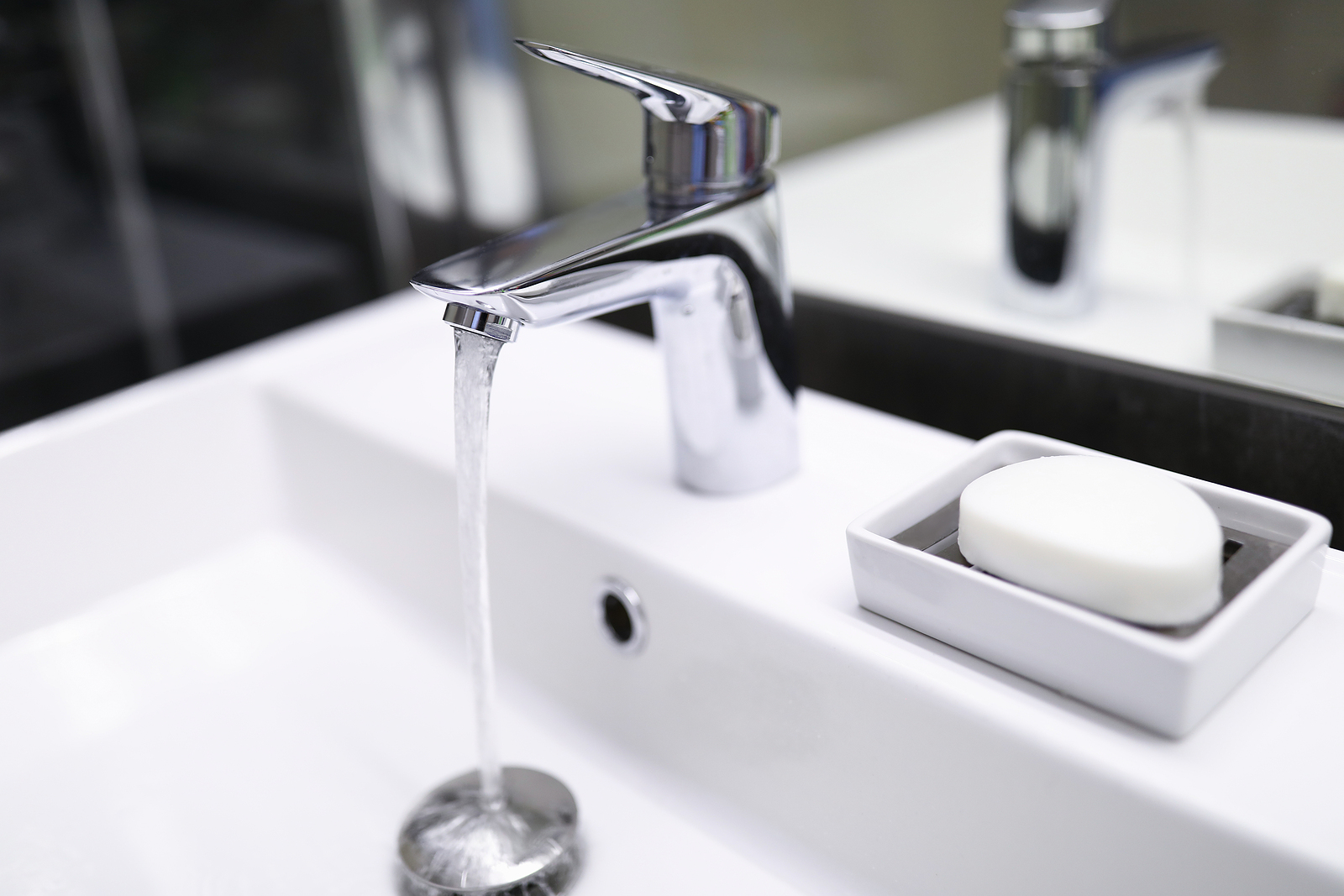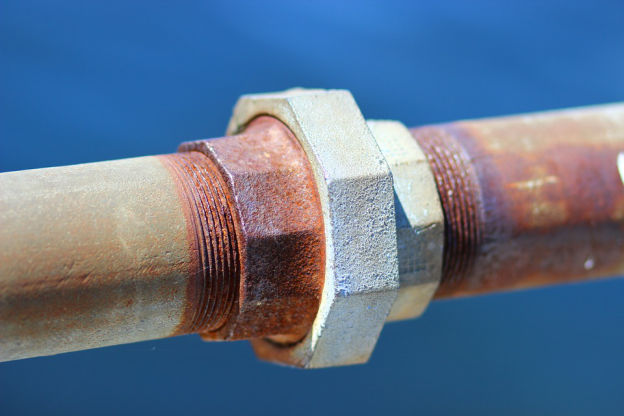If you're struggling with low water pressure in your bathroom sink, a pressure booster could be the solution you've been looking for. This device works by increasing the pressure of the water as it travels through your pipes, resulting in a more powerful flow from your faucet. Pressure boosters can be installed on individual fixtures, such as your bathroom sink, or on your main water supply line for overall increased pressure throughout your home. When shopping for a pressure booster, be sure to look for one that is specifically designed for the type of plumbing system you have. It's also important to consider the size and capacity of the booster to ensure it can handle the demands of your household.1. Increase water pressure in bathroom sink with a pressure booster
If you have a water pressure regulator in your home, it could be the cause of your low water pressure. These devices are typically installed near the main water supply line and are responsible for regulating the water pressure throughout your plumbing system. If the pressure is set too low, it can result in weak water flow from your bathroom sink. To adjust the water pressure regulator, you will first need to locate it. This can usually be found near your main water shut-off valve. Using a wrench, you can turn the adjustment screw to increase the pressure. It's important to do this slowly and carefully, as too much pressure can cause damage to your pipes.2. Adjust the water pressure regulator in your home
The aerator on your bathroom sink faucet is a small device that screws onto the end of the faucet. Its purpose is to mix air with the water, resulting in a more even and gentle flow. However, over time, the aerator can become clogged with sediment and mineral deposits, causing a decrease in water pressure. To clean the aerator, you can unscrew it from the faucet and soak it in a solution of equal parts water and vinegar. This will help dissolve any buildup and restore the aerator to its full function. If the aerator is damaged or too clogged to be cleaned, it may be time to replace it with a new one.3. Clean the aerator on your bathroom sink faucet
Another common cause of low water pressure in bathroom sinks is clogs or blockages in the pipes. This can be caused by a buildup of debris, such as hair, soap scum, or mineral deposits. To check for clogs, you can remove the P-trap under the sink and use a plumbing snake or wire hanger to remove any blockages. If you're not comfortable doing this yourself, you can also call a professional plumber to take care of it for you. They have the tools and expertise to effectively remove any clogs and restore your water pressure.4. Check for any clogs or blockages in the pipes
While this may seem counterintuitive, installing a new, high-pressure showerhead can actually help increase the water pressure in your bathroom sink. This is because the water supply for both the showerhead and the sink faucet come from the same source, so a more powerful showerhead will also result in increased pressure for your sink. When choosing a high-pressure showerhead, look for one with a high PSI (pounds per square inch) rating and multiple spray settings. This will give you the most control over the water pressure and flow.5. Install a new, high-pressure showerhead
If your home has old or worn out pipes, they could be restricting the flow of water and causing low water pressure. This is especially common in older homes with galvanized steel pipes, which can corrode and become clogged over time. To determine if your pipes need to be replaced, you can have a professional plumber inspect them. They can also provide you with options for new, more efficient pipes that will improve your water pressure and overall plumbing system.6. Replace old or worn out pipes
A water pressure gauge is a small device that can be installed on your main water supply line to monitor the pressure levels in your home. This can be helpful in identifying any sudden drops in pressure or inconsistencies throughout different fixtures. If you notice a significant decrease in pressure, you may have a leak or other issue that needs to be addressed. A water pressure gauge can also help you determine if your efforts to increase water pressure in your bathroom sink are working.7. Install a water pressure gauge to monitor levels
Leaks in your plumbing system can not only waste water, but they can also cause a decrease in water pressure. This is because the water is not able to flow freely through the pipes and is being diverted elsewhere. To check for leaks, you can turn off all water sources in your home and check your water meter. If it is still moving, you likely have a leak. Leaks can often be fixed with a simple repair, but it's important to address them as soon as possible to avoid further damage and costly water bills.8. Check for any leaks in the plumbing system
If your bathroom sink faucet does not have a built-in water pressure regulator, you can install one to help control the flow of water. These devices can be found at most hardware stores and can be easily installed by following the manufacturer's instructions. A water pressure regulator can be especially useful if you have multiple people using the bathroom sink at once, as it can prevent drastic changes in water pressure.9. Install a water pressure regulator on the bathroom sink faucet
If you have exhausted all other options and are still struggling with low water pressure in your bathroom sink, it may be time to consider upgrading to a larger water supply line. This will allow for a greater volume of water to flow through your pipes, resulting in increased pressure. This is a more extensive and expensive solution, but it can greatly improve the overall water pressure in your home, not just in your bathroom sink. By following these tips, you can increase water pressure in your bathroom sink and enjoy a more powerful and efficient flow. Remember to regularly maintain your plumbing system to prevent any future issues with low water pressure. And if you're unsure of how to handle a particular problem, don't hesitate to call a professional plumber for assistance.10. Consider upgrading to a larger water supply line for increased pressure
Increase Water Pressure in Bathroom Sink for an Enhanced Home Design

The Importance of Water Pressure in a Bathroom Sink
 When it comes to designing a house, every detail matters. From the color of the walls to the type of flooring, each element contributes to the overall aesthetic and functionality of a home. One aspect that is often overlooked in house design is water pressure in the bathroom sink. This may seem like a minor detail, but it can greatly impact the overall experience in the bathroom. Low water pressure can lead to frustration and inconvenience, while high water pressure can cause splashing and mess. That's why it's important to have just the right water pressure in your bathroom sink.
Increasing Water Pressure for a More Efficient Bathroom Sink
There are various reasons why the water pressure in your bathroom sink may be low. It could be due to clogged pipes, a faulty faucet, or even an outdated plumbing system. Whatever the reason may be, it's important to address it in order to achieve optimal water pressure. One simple and effective solution is to install a water pressure booster. This device can help increase the water pressure in your bathroom sink, providing you with a more efficient and enjoyable experience.
When it comes to designing a house, every detail matters. From the color of the walls to the type of flooring, each element contributes to the overall aesthetic and functionality of a home. One aspect that is often overlooked in house design is water pressure in the bathroom sink. This may seem like a minor detail, but it can greatly impact the overall experience in the bathroom. Low water pressure can lead to frustration and inconvenience, while high water pressure can cause splashing and mess. That's why it's important to have just the right water pressure in your bathroom sink.
Increasing Water Pressure for a More Efficient Bathroom Sink
There are various reasons why the water pressure in your bathroom sink may be low. It could be due to clogged pipes, a faulty faucet, or even an outdated plumbing system. Whatever the reason may be, it's important to address it in order to achieve optimal water pressure. One simple and effective solution is to install a water pressure booster. This device can help increase the water pressure in your bathroom sink, providing you with a more efficient and enjoyable experience.
The Benefits of Having the Right Water Pressure in Your Bathroom Sink
 Having the right water pressure in your bathroom sink not only enhances the overall design of your home, but it also has other benefits. For one, it can save you time and energy. With proper water pressure, you won't have to spend extra time rinsing off soap or shampoo, allowing you to get ready faster. It can also save you money by reducing water usage. Additionally, proper water pressure can prevent the buildup of bacteria and mold, promoting a cleaner and healthier bathroom environment.
Consulting with a Professional for the Best Results
While there are various DIY solutions to increase water pressure in your bathroom sink, it's always best to consult with a professional. They can assess the cause of the low water pressure and provide you with the most effective solution. They may also recommend other improvements to your plumbing system, ensuring long-term efficiency and functionality.
In conclusion, increasing water pressure in your bathroom sink is a crucial aspect of house design. It not only enhances the overall aesthetic, but it also improves efficiency and saves you time and money. So don't overlook this small detail and consult with a professional for the best results. With the right water pressure, your bathroom sink can become a functional and beautiful addition to your home.
Having the right water pressure in your bathroom sink not only enhances the overall design of your home, but it also has other benefits. For one, it can save you time and energy. With proper water pressure, you won't have to spend extra time rinsing off soap or shampoo, allowing you to get ready faster. It can also save you money by reducing water usage. Additionally, proper water pressure can prevent the buildup of bacteria and mold, promoting a cleaner and healthier bathroom environment.
Consulting with a Professional for the Best Results
While there are various DIY solutions to increase water pressure in your bathroom sink, it's always best to consult with a professional. They can assess the cause of the low water pressure and provide you with the most effective solution. They may also recommend other improvements to your plumbing system, ensuring long-term efficiency and functionality.
In conclusion, increasing water pressure in your bathroom sink is a crucial aspect of house design. It not only enhances the overall aesthetic, but it also improves efficiency and saves you time and money. So don't overlook this small detail and consult with a professional for the best results. With the right water pressure, your bathroom sink can become a functional and beautiful addition to your home.





/low-water-pressure-2718732-05-99eb1816e88841c593aeeaaaf330085b.jpg)


















:max_bytes(150000):strip_icc()/ac3-56a73c5a5f9b58b7d0e81836.jpg)
/cleaning-the-aerator-from-deposits--the-girl-hand-washes-a-dirty-limestone-aerator-with-water-1126244919-72868100964f42d5aa564a928371fea5.jpg)
/RemovingAeratorAssembly-99881d30169b43cebc3fe72f6d4b25b9.jpg)







.png)
















































































/modern-dining-room-ideas-4147451-hero-d6333998f8b34620adfd4d99ac732586.jpg)


